NORTHERN CALIFORNIA
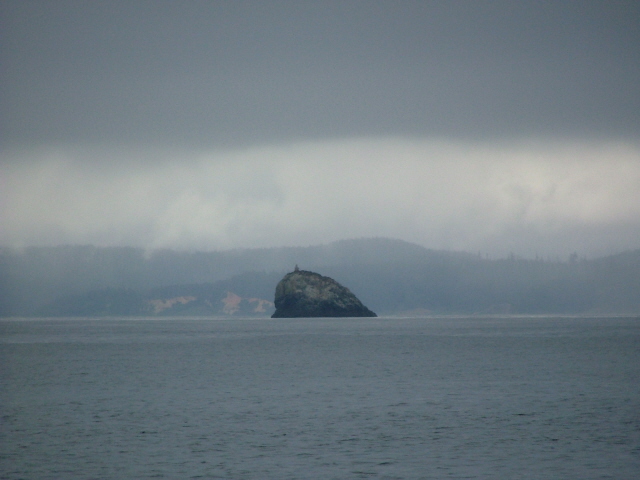 Light and variable winds greeted us as
we entered the waters of California. We left Port Orford, Oregon
early in the morning to ensure a daylight arrival at Crescent
City. Although occasionally enshrouded in fog, we did manage a
few views of the coastline. This is Reading Rock, a very large
rock that stands well off shore and has an automated light to
warn navigators of its presence. We remember it well from our
last trip down the coast due to its uncanny resemblance to a
certain part of the human female anatomy.
Light and variable winds greeted us as
we entered the waters of California. We left Port Orford, Oregon
early in the morning to ensure a daylight arrival at Crescent
City. Although occasionally enshrouded in fog, we did manage a
few views of the coastline. This is Reading Rock, a very large
rock that stands well off shore and has an automated light to
warn navigators of its presence. We remember it well from our
last trip down the coast due to its uncanny resemblance to a
certain part of the human female anatomy.
Crescent City was our first stop in Northern
California. We only spent two days there and neglected to take
any photos. That's regrettable because the coast around Crescent
City is quite beautiful.
 A memorable aspect of our last cruise
was the arrival of avian crewmembers. Our first winged passenger
of this trip arrived on board not long after we passed Reading
Rock. This little guy is a Gold Finch (we believe) and he (she?)
was a good 10 miles offshore when he landed on Kavenga.
He spent most of his time on board looking for a sheltered spot
out of the wind where he could sleep. Here he's under the dodger
on the main hatch with his head beneath his wing, and his tail
resting on our navigation logbook. Twice he tried to fly towards
land after resting but he'd only make it about a 100 yards before
realizing land was too far. He'd then return and take another
nap. We became concerned that he was going to keep doing this
until he wore himself out trying to make it to land. Kay was
easily able to pick him up and put him in a white bucket with a
towel on the bottom and over the lid. Our plan was to release him
when we reached Eureka in a few hours. Kay checked on him
frequently and all seemed well. However, just as we were nearing
Eureka we found that he had expired. Kay conducted a shoreside
funeral in Eureka on the banks of the Humboldt River.
A memorable aspect of our last cruise
was the arrival of avian crewmembers. Our first winged passenger
of this trip arrived on board not long after we passed Reading
Rock. This little guy is a Gold Finch (we believe) and he (she?)
was a good 10 miles offshore when he landed on Kavenga.
He spent most of his time on board looking for a sheltered spot
out of the wind where he could sleep. Here he's under the dodger
on the main hatch with his head beneath his wing, and his tail
resting on our navigation logbook. Twice he tried to fly towards
land after resting but he'd only make it about a 100 yards before
realizing land was too far. He'd then return and take another
nap. We became concerned that he was going to keep doing this
until he wore himself out trying to make it to land. Kay was
easily able to pick him up and put him in a white bucket with a
towel on the bottom and over the lid. Our plan was to release him
when we reached Eureka in a few hours. Kay checked on him
frequently and all seemed well. However, just as we were nearing
Eureka we found that he had expired. Kay conducted a shoreside
funeral in Eureka on the banks of the Humboldt River.
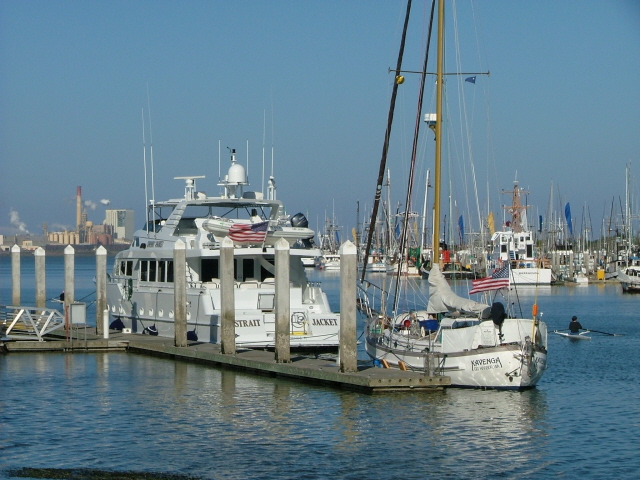
By process of elimination we wound up at what is
called the Bonnie Gool Dock in downtown Eureka. The Municipal
Marina had no "deep draft" slips available and we
didn't relish having to cross the bridge to town from the Woodley
Island marina (seen in the background). This dock did not exist
when were here 14 years ago. It's meant to be a dock for
short-term visitors, which we thought we were, and it is
right downtown, close to all the services we cruisers need.
During what turned into a two-week stay we were
alone at the dock most of the time. One of our few dockmates was
this 110-foot motor yacht, Strait Jacket. We learned
from a reliable source that it belonged to a celebrity, a
country-western singer who wished to remain anonymous. If that is
really the case, one would think he'd name his boat something
else, because even non-fans of CW music such as ourselves were
able to quickly deduce the owner's identity. However, he was not
aboard for absolute verification.
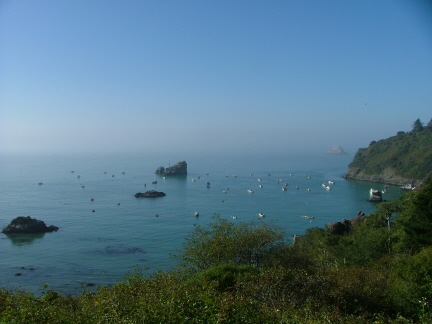
This is the anchorage at Trinidad Head. We passed by Trinidad
on our way south from Crescent City to Eureka, but not close
enough to get a good look at it. We decided to pull in for a
quick look via rental car on our way north to go horseback
riding. Once we saw it, we wished we'd had time for a stop. It's
a lovely place and there's a suprisingly large supermarket and
other services here for the advertised population of only 331.
The only negatives are the lack of protection from southerly
winds (not common in the summer) and having to anchor out beyond
all of the small recreational fishing boats on private moorings.
Still, that would be a small price to pay for stopping at such a
scenic place.
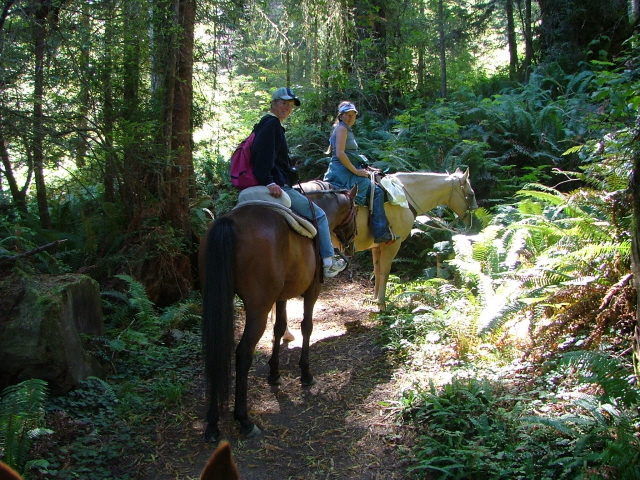
We decided to splurge and go for a long (4-hour) horseback
ride through a loop in the Redwoods National Forest near the
small town of Orick, California, about a 45-minute drive north of
Eureka. Here's Kay on "Joe" and Sis, the proprietor and
guide on "Goldie" just as we were heading up the trail.
Little did we expect the calamity that was coming as we neared
the end of the ride.
Whether it was intentional or an accident on Joe's part is
still subject to debate. Steve witnessed what happened from
behind and said that Joe just suddenly fell over on his side,
giving Kay no warning. Kay's foot, ankle and lower leg were
caught underneath the horse, crushing her foot and breaking her
fibula just above the ankle. Kay managed to ride Joe out with Sis
leading him. Steve then drove us to the Mad River Community
Hospital in Arcata where x-rays revealed the fracture.
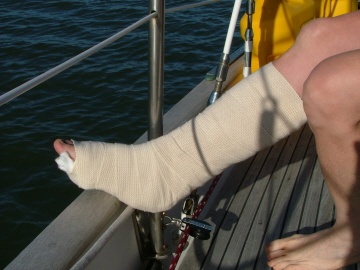
Here's the soft cast that Kay wore for the first week after
the accident. Dr. Lyell, the orthopedic surgeon who later applied
the fiberglass hard cast, was not impressed with this one.
However, he said if Kay had managed to get by with it for a week,
that meant the the fracture was stable.
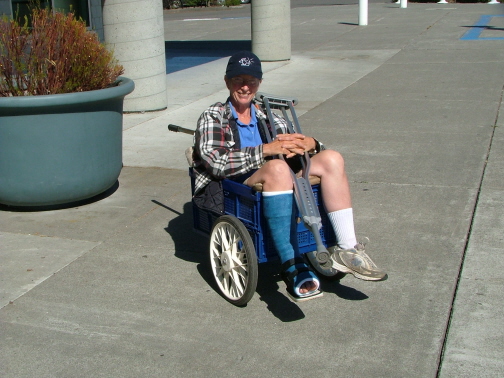
And here's Kay in the "rickshaw" that Steve
occasionally towed her around in. She also has her new hard cast
in this shot. There are quite a few homeless people in Eureka.
Consequently, no one seemed to take much notice of a man hauling
his wife around town in a dock cart! Actually, Kay did quite a
bit of walking with her crutches. The cart just added extra range
when we wanted to go a little farther from the boat.
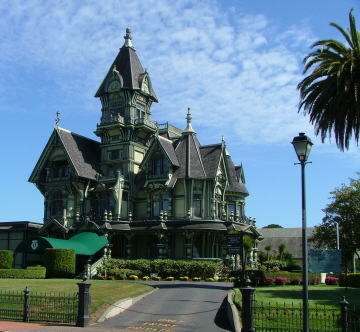 One of the attractions of Eureka is it's restored
Victorian mansions, this one the Carson Mansion being the biggest
and boldest example. It's now used as a private club facility.
One of the attractions of Eureka is it's restored
Victorian mansions, this one the Carson Mansion being the biggest
and boldest example. It's now used as a private club facility.
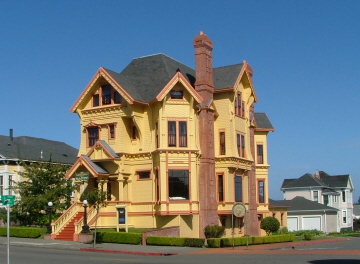 This one is now a B&B.
This one is now a B&B.
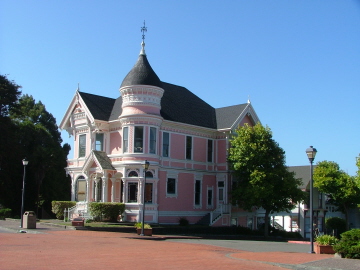
And this one, and architect's office. The detail in the
woodwork is amazing.

You know you've been in one place too long when the local
artists begin to paint pictures of you. This gentleman, whose
name we did not get, spent a few hours on a nice weekend day,
doing this water-color of Kavenga.
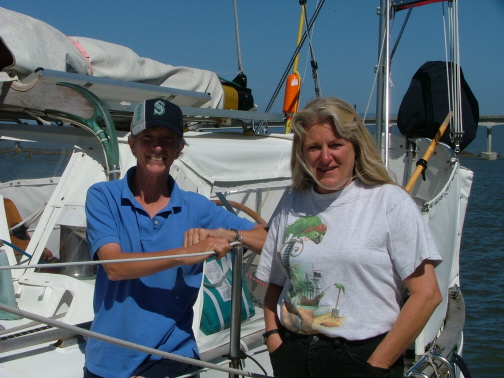
Here's Kay with Laurie Giacoma, Commodore of the Humboldt
Yacht Club, and our best friend in Eureka. Although it was very
bad luck for Kay to have her leg broken, we were very fortunate
that it happened in Eureka. We had re-joined HYC prior to leaving
Gig Harbor. We had joined 14 years ago on our way down the coast
that time. Thanks to Laurie (and also Ralph and Nona Kraus) we
had transportation whenever we needed it to take Kay to the
doctor, etc.
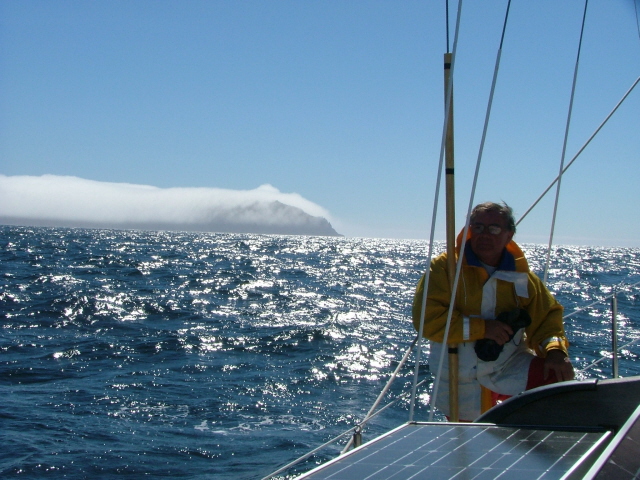
Once Kay had her hard cast, we were ready to move again, but
we were concerned that she would not be able to handle her crew
responsibilities. This was confirmed by Dr. Lyell and friends in
the medical field who said she could go on the passage to San
Francisco, but only as a "princess passenger".
Fortunately, we had a good friend, Jerry Kimble, whom we had
met in the South Pacific on our last cruise, who offered to take
a 12-hour bus ride from San Jose to help us sail Kavenga
to the Bay. Here's Jerry with Point Reyes in the background,
enshrouded in fog.
Point Reyes juts west like a capital-L into the Pacific,
forming Drake's Bay on it's southern side.
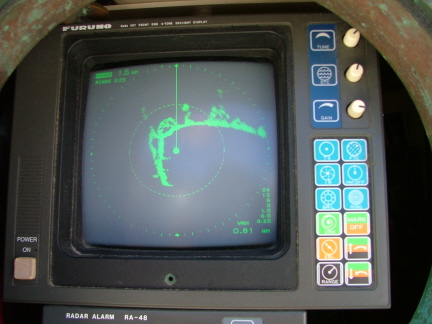 In 1990 we had to find our way into Drake's Bay
using radar and depthsounder due to pea-soup fog. This time we
had GPS (Global Positioning System) and sonar in addition to
those instruments. However, the fog cleared away this day and we
had perfect visibility. But just to give you an idea of how relatively
easy it is to navigate into this large bay by radar, here's a
shot of the radar screen as it appeared from where we anchored.
Coincidentally, the GPS indicated that we dropped anchor at
exactly 38-00.000 north latitude.
In 1990 we had to find our way into Drake's Bay
using radar and depthsounder due to pea-soup fog. This time we
had GPS (Global Positioning System) and sonar in addition to
those instruments. However, the fog cleared away this day and we
had perfect visibility. But just to give you an idea of how relatively
easy it is to navigate into this large bay by radar, here's a
shot of the radar screen as it appeared from where we anchored.
Coincidentally, the GPS indicated that we dropped anchor at
exactly 38-00.000 north latitude.
Our position is the dot at the center with the heading line
extending up toward 12-o'clock, which coincidentally happened to
be approximately north at this time. The bright green image
around us is the shoreline of Drake's Bay.
To enter the bay in fog, one just needs to stay a mile
offshore until the southern point is rounded. One can then
proceed into the bay, monitoring the depthsounder until a
comfortable depth for anchoring is reached. We anchored in about
18 feet. (Tilting your screen may darken the image for a better
view.)
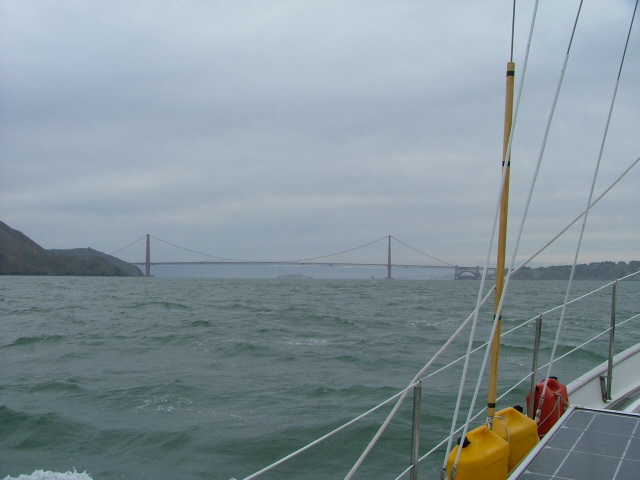
We stayed at Drake's Bay overnight to time our entrance to San
Francisco to coincide with the start of the flood (ingoing)
current. Despite overcast skies, we had good views of the coast
from Drake's Bay all the way to the Golden Gate Bridge. On our
last cruise we didn't see the bridge until we were almost
underneath it.
Here we have just rounded close around Point Bonita, although
this view makes it look as though we are out in the middle of the
channel.
You can just barely see Alcatraz Island, the former maximum
security prison in the distance beyond mid-span.
We stayed out of the main ship channel and passed close to the
north tower on the left.

Since we caught the start of the flood current in the morning
we decided to continue on up the Sacramento and San Joaquin
Rivers to see if we could ride the favorable tide all the way to
Jerry's place in the Delta.
Just after passing beneath the Richmond-San Rafael Bridge we
passed by The Brothers Islands.
Some enterprising people have built a unique Bed &
Breakfast on one of them. As you can see, they are not much more
than rocks.
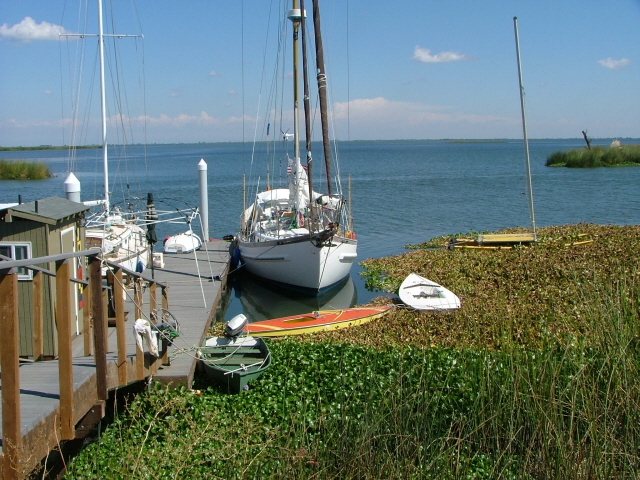
Here's Kavenga at Jerry's dock on Bethel Island. Kavenga
is surrounded by water hyacinths and just a small part of Jerry's
fleet: aluminum fishing boat, Sunfish, Force 5, and Hobie Cat. He
also has a ski boat, bowrider, jet ski, two Waveriders, and a
Whitehall rowing gig, in addition to the houseboat and his
sailboat, Audrey.
The gap in the back is a breach in the old levee that once
surrounded Frank's Tract, a former cow pasture, which is now a
flooded shallow lake.

Water hyacinths are quite beautiful. However, they are also
prolific and can become a hazard to navigation. Consequently, the
local government periodically comes around and sprays them. In
the photo above you see healthy, unsprayed hyacinths in the
foreground and sprayed and dying hyacinths out around the Hobie
Cat.

Being a huge wetland, it is to be expected that the variety of
birdlife is extensive. We've seen a lot of brown pelicans on this
trip but we've only seen a few of these white pelicans thus far.
Cormorants, gulls terns, bitterns, and various species of wading
birds and hawks abound.

Egrets are as common in California as Great Blue Herons are in
our home area of Puget Sound. This fellow was quite cooperative
and maintained his perch while we made a couple of circles nearby
in our inflatable dinghy.
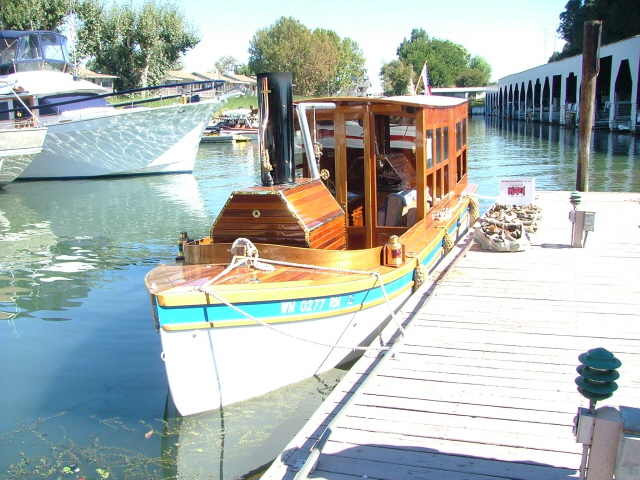
Our host, Jerry, took us in his bowrider speedboat to a
steamboat rally at a marina about 10 miles from Bethel Island.
This was the star of the show, a 30-foot steam powered
stern-wheeler built in Spokane, Washington. Thanks to a favor
that Jerry had done for the owner the day before, we were all
treated to a ride on the Mokelumne River.
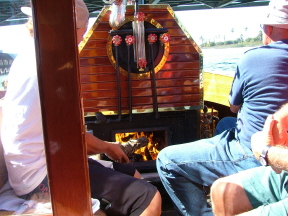
It was a little unusual to see the owner's son open the door
to the boiler and toss another log on the fire in order to keep
up steam pressure. Compared to a gas or diesel engine, the steam
engine is almost silent, just the metallic clicking of the twin
driveshafts and their associated mechanisms.
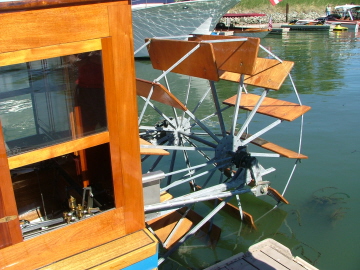
The owner spent twenty years building his stern-wheeled steam
launch. It is an amazing concoction of gadgetry, engineering and
beautiful woodwork.
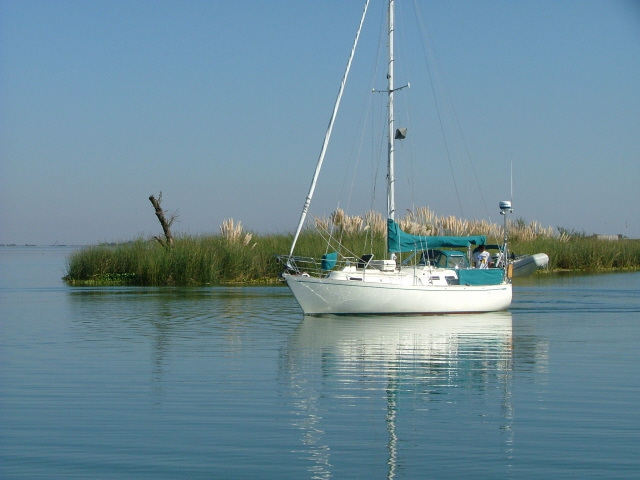
In one of life's little coincidences, Stan Brice, a former
dock neighbor of ours back at our home marina in Gig Harbor,
happened to run into Steve at the West Marine in Antioch. With
the welcome of our host, Jerry, Stan came up and spent a few days
with us at Bethel Island.
Stan loves his folding bike as much as we love ours and we
went on several rides together. Here's Stan in Mar Y Joe
leaving Bethel Island to explore other parts of the a-Maze-ing
California Delta. Both Kavenga and Mar Y Joe
plan to be on their way back to the San Francisco Bay and points
south in the near future.
Home
 Light and variable winds greeted us as
we entered the waters of California. We left Port Orford, Oregon
early in the morning to ensure a daylight arrival at Crescent
City. Although occasionally enshrouded in fog, we did manage a
few views of the coastline. This is Reading Rock, a very large
rock that stands well off shore and has an automated light to
warn navigators of its presence. We remember it well from our
last trip down the coast due to its uncanny resemblance to a
certain part of the human female anatomy.
Light and variable winds greeted us as
we entered the waters of California. We left Port Orford, Oregon
early in the morning to ensure a daylight arrival at Crescent
City. Although occasionally enshrouded in fog, we did manage a
few views of the coastline. This is Reading Rock, a very large
rock that stands well off shore and has an automated light to
warn navigators of its presence. We remember it well from our
last trip down the coast due to its uncanny resemblance to a
certain part of the human female anatomy. A memorable aspect of our last cruise
was the arrival of avian crewmembers. Our first winged passenger
of this trip arrived on board not long after we passed Reading
Rock. This little guy is a Gold Finch (we believe) and he (she?)
was a good 10 miles offshore when he landed on Kavenga.
He spent most of his time on board looking for a sheltered spot
out of the wind where he could sleep. Here he's under the dodger
on the main hatch with his head beneath his wing, and his tail
resting on our navigation logbook. Twice he tried to fly towards
land after resting but he'd only make it about a 100 yards before
realizing land was too far. He'd then return and take another
nap. We became concerned that he was going to keep doing this
until he wore himself out trying to make it to land. Kay was
easily able to pick him up and put him in a white bucket with a
towel on the bottom and over the lid. Our plan was to release him
when we reached Eureka in a few hours. Kay checked on him
frequently and all seemed well. However, just as we were nearing
Eureka we found that he had expired. Kay conducted a shoreside
funeral in Eureka on the banks of the Humboldt River.
A memorable aspect of our last cruise
was the arrival of avian crewmembers. Our first winged passenger
of this trip arrived on board not long after we passed Reading
Rock. This little guy is a Gold Finch (we believe) and he (she?)
was a good 10 miles offshore when he landed on Kavenga.
He spent most of his time on board looking for a sheltered spot
out of the wind where he could sleep. Here he's under the dodger
on the main hatch with his head beneath his wing, and his tail
resting on our navigation logbook. Twice he tried to fly towards
land after resting but he'd only make it about a 100 yards before
realizing land was too far. He'd then return and take another
nap. We became concerned that he was going to keep doing this
until he wore himself out trying to make it to land. Kay was
easily able to pick him up and put him in a white bucket with a
towel on the bottom and over the lid. Our plan was to release him
when we reached Eureka in a few hours. Kay checked on him
frequently and all seemed well. However, just as we were nearing
Eureka we found that he had expired. Kay conducted a shoreside
funeral in Eureka on the banks of the Humboldt River.




 One of the attractions of Eureka is it's restored
Victorian mansions, this one the Carson Mansion being the biggest
and boldest example. It's now used as a private club facility.
One of the attractions of Eureka is it's restored
Victorian mansions, this one the Carson Mansion being the biggest
and boldest example. It's now used as a private club facility. This one is now a B&B.
This one is now a B&B.



 In 1990 we had to find our way into Drake's Bay
using radar and depthsounder due to pea-soup fog. This time we
had GPS (Global Positioning System) and sonar in addition to
those instruments. However, the fog cleared away this day and we
had perfect visibility. But just to give you an idea of how relatively
easy it is to navigate into this large bay by radar, here's a
shot of the radar screen as it appeared from where we anchored.
Coincidentally, the GPS indicated that we dropped anchor at
exactly 38-00.000 north latitude.
In 1990 we had to find our way into Drake's Bay
using radar and depthsounder due to pea-soup fog. This time we
had GPS (Global Positioning System) and sonar in addition to
those instruments. However, the fog cleared away this day and we
had perfect visibility. But just to give you an idea of how relatively
easy it is to navigate into this large bay by radar, here's a
shot of the radar screen as it appeared from where we anchored.
Coincidentally, the GPS indicated that we dropped anchor at
exactly 38-00.000 north latitude.








